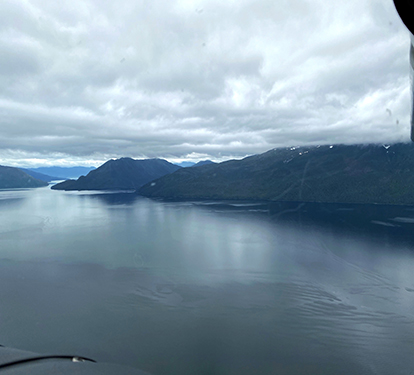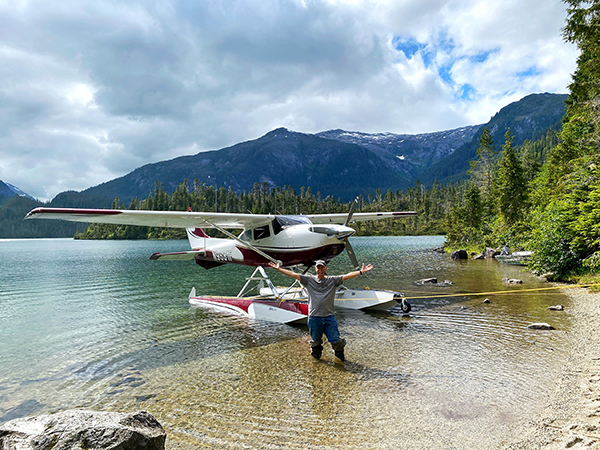
by Ken Wittekiend
Copyright 2020. All rights reserved!
Published in Midwest Flyer Magazine (online) – December 2020/January 2021 issue
Skylane N9681 Foxtrot is returning to Medford with an engine problem,” I radioed the tower at Rogue Valley International – Medford Airport (KMFR) in Medford, Oregon, on July 7, 2020. I had just departed the central Oregon airport on the next leg of my journey to southeast Alaska in my 1998 Cessna 182S amphibian, when suddenly, the whole adventure seemed to be in jeopardy, due to a stuck exhaust valve.
The planning for the trip had begun months earlier after reading about the “public-use cabins” in the Tongass National Forest, many of which were accessible only by floatplane. The photos and descriptions of the beauty and majesty of these remote areas seemed to offer a perfect escape from the furnace-like heat of another central Texas summer, despite the added challenge and complexity of the Covid-19 pandemic.
As I began researching the feasibility of making an extended trip, I found a wonderful source of inspiration, information and advice from Bill Rusk, a Southwest Airlines captain and Super Cub owner from Sandpoint, Idaho, who has spent the last several summers exploring the area and writing about his experiences. Bill has been unfailingly helpful and gracious, answering a multitude of questions with patience and kindness. He was instrumental in convincing me to undertake the journey. Here is a link to one of Bill’s presentations: www.youtu.be/XUmYom9KPJ4
I was also aided by an amazing resource put together by Tom Bass of Kalispell, Montana. His exhaustive website www.publiclakecabinsak.com on Alaska public-use cabins gave me detailed information about how to select and reserve the various cabins throughout the area, along with many suggestions about resources and gear that I would need.
I had been to Alaska twice before. First in my Super Cub on wheels in 2013 when a group of friends helped me explore the Alaskan backcountry for several weeks. I returned to the Kenai area in 2017 after my buddy Mike offered access to his floatplane. During that adventure, we spent three weeks visiting the lakes around Talkeetna, the Kenai Peninsula and Southwest Alaska. While the floatplane offered a way to see the remote regions in a different way from a bush plane on wheels, it came with limitations. Since we did not wish to land in saltwater, finding fuel and facilities became a great deal more difficult. I quickly realized that having an amphibian floatplane would offer the best option. This would allow me to utilize a far greater choice of airports where we could resupply, refuel and recharge when we needed a night in a hotel, rather than in a remote cabin.
“Cessna N9681 Foxtrot, are you declaring an emergency?” asked the Cascade Approach controller as I completed the 180-degree course reversal.”
“Affirmative,” I responded while noticing the loss of power on my #5 cylinder. I was not quite able to maintain altitude, but the Medford airport was several thousand feet lower and only a few miles away. The controller diverted some traffic from the pattern and cleared me for a straight-in approach. After an uneventful landing, I taxied to the FBO and shut down.
Thanks to the folks at Medford Jet Center, they found the time in their busy schedule to replace the bent pushrod and ream the remaining valve guides to reduce the possibility of further problems. After spending the weekend waiting on parts and repairs to be completed, I started north once again.
With 88 gallons of usable fuel, it looked like it might be possible to make the leg non-stop from Bellingham, Washington to Ketchikan, Alaska. This would require favorable weather and winds, but it would avoid the problems of going through Canada at a time when concerns over Covid-19 meant fewer airports of entry available and the possibility that I would be denied entry altogether. After waiting an extra day in Bellingham, favorable weather meant I could launch for Alaska, but the winds meant I would need to transit Canada for fuel after all. I filed the requisite U.S. Customs & Border Protection electronic Advance Passenger Information System (eAPIS) flight manifest, and the International Civil Aviation Organization (ICAO) flight plan and notified the Canada Border Services Agency (CBSA) of my ETA to Prince Rupert (CYPR) to clear Customs.
I took off from the British Columbia coast, and as predicted, the winds were on the nose most of the way. The views of the coast were absolutely stunning with old growth forests surrounding quiet inlets with the thrill of an occasional whale sighting. Sometimes the flight path took me out over the Pacific where swells crashed against the rocky shoreline, and it was obvious that this was no place for an engine problem, even in a floatplane.
I was happy to see the runway at CYPR come into view after almost 5 hours of flying. Once I landed and called Canada Customs, they agreed to meet me, but then delivered a bit of unexpected news. Turns out that only jet fuel is available at Prince Rupert. For avgas, I would need to go to the nearby seaplane base of Seal Cove. So, after a short break, I took off and immediately landed in the saltwater bay below Prince Rupert and proceeded to search for the seaplane base. I finally asked a friendly fellow in a fishing boat, and he pointed me in the right direction.
Tying up to the dock, I was met by a couple of Customs officers who quickly took care of the required paperwork and welcomed me to Canada with an admonition that I was not allowed to stay. After refueling, filing my flight plan and eAPIS notification, I departed from the bay and headed north through the waters of the Inland Passage, passing Ketchikan on my way to Juneau. After another 2.5 hours of flying, I entered the Gastineau Channel for the final approach to Juneau International Airport (PAJN).
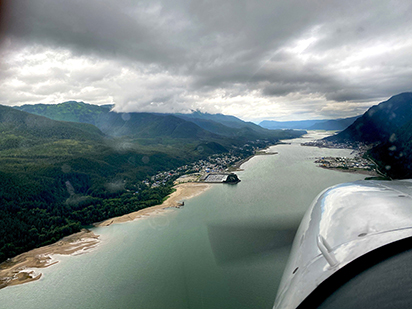
Despite the lowering ceiling, light rain and fatigue from a really long day, the Juneau tower controller welcomed me and quickly cleared me to land. He also provided a “Follow Me” truck to guide me to the U.S. Customs facility, which was hidden due to airport construction. Stephanie, a friendly Customs officer, helped me with the paperwork and the required Covid-19 test, after which I loaded my backpack and walked to the nearby motel for the night.
Over the next seven weeks, I was joined by several friends and family members who flew to Alaska on the airlines via either Juneau or Ketchikan.
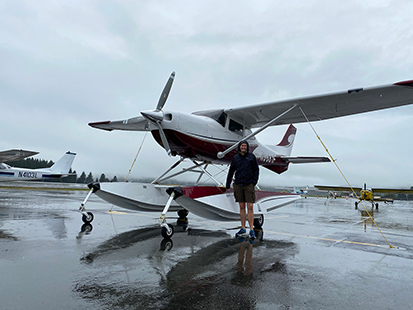
Each time, we would load up the floatplane with gas and groceries and fly out to one of the remote cabins for a few days. Upon our arrival, we would unload our camping gear and supplies, secure the floatplane and begin exploring the area.
Although the cabins vary in size and design, they are all very basic with a source of heat, either an oil or wood stove.

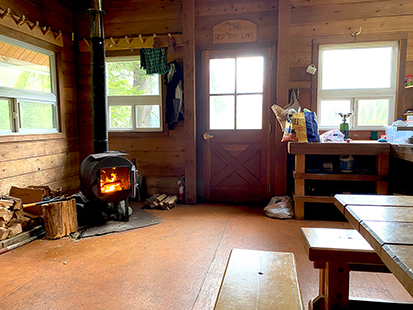

The U.S. Forest Service tries to provide firewood for the wood stoves, but many of the cabins were either out of wood or extremely low, probably due to the problems with Covid-19, impacting their ability to resupply. The oil stoves require fuel oil which visiting pilots are required to furnish. While the oil stoves work well, we really enjoyed the ambiance of the wood stove on a cold morning.
Each cabin had a couple of sleeping platforms where we could roll out our sleeping bags and air mattresses. No lights, no cell phone service, and of course, no Internet, meant forced relaxation and led to a renewed appreciation of the joys of being in the wilderness where we watched the clouds, rain and sun play over the pristine waters of the remote lakes. Occasionally, we saw otters, beavers, ducks and one large black bear which appeared to be about 100 yards from us, down the beach at the Salmon Lake cabin. I managed to take a couple of photos before he turned and disappeared into the alders.
Each of my guests commented on the astounding silence. We forget how noisy our usual environment is until we are suddenly in a place so quiet that we find ourselves whispering because it somehow seems appropriate. The only sounds are often the call of the birds, the waves lapping against the hull of the floatplane or the wind gently moving through the forest.
Each cabin has an aluminum skiff furnished by the U.S. Forest Service. Although there are oars for propulsion, my friend Bill Rusk had suggested bringing a small outboard motor along to expand our ability to explore the various waterways. The 2.5 hp Suzuki outboard only weighed 30 lbs. and made a huge difference. With it, we could easily get on the water and go fishing. We often caught fish for supper, which we fried up back at the cabin. Once, I managed to hook and land an 8 lb. Salmon which my wife turned into three delicious meals.
Each day’s schedule depended on the weather. When it wasn’t raining, we usually arose early and fixed a leisurely breakfast. Then, we would either go fishing or hiking. If the weather didn’t cooperate, we would build a fire and spend hours reading. In early July, the daylight lingers late during the Alaskan summer, so we sometimes would turn in while it was still light outside. But by the end of the trip, darkness was coming much earlier in the day.
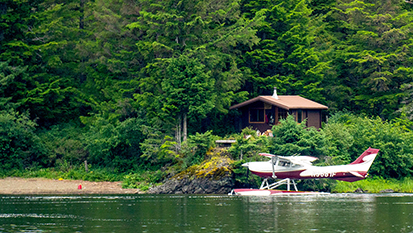
Southeast Alaska experienced an extremely wet summer, setting all-time records for rainfall this year. This often meant we had significant challenges getting around to the cabins and back to town. Even in a normal year, the weather changes rapidly and requires a great deal of effort to operate safely. If we were in town, we could access weather information via the internet and by calling the briefers at Flight Service. In Alaska, these are staffed by FAA specialists who are very familiar with the local weather. There are also numerous weather observation cameras located throughout the region, which provide a real-time look at the conditions. However, once out in the cabins, acquiring weather information is more challenging. I used a satellite phone and a Garmin In-Reach device, which let me get a sense of what was going on with the weather.
As a general rule, the ceiling and visibility was better out over the ocean than it would be inland where the freshwater lakes were located. Occasionally, we would be trapped at a cabin by low ceilings and had to wait for improving conditions before heading into town.
Mixing high terrain, remote locations and poor weather provided lots of challenges in moving around the area. Rarely, the weather would clear, and the incredible scenery would reveal itself. Deep blue water with dark mountains rising steeply to snow-covered peaks made an awe-inspiring backdrop as we flew through the straits and fjords, carved by glaciers eons ago.
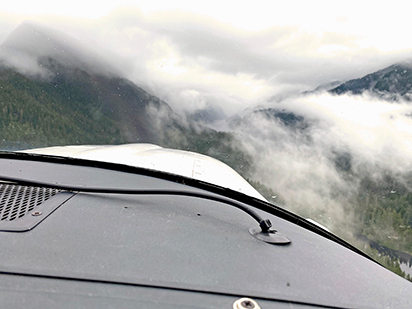
During August and into early September, I had the opportunity to share the experience with my wife, Judy, and my son, Jeff, along with several close friends who relished the chance to see a part of Alaska that so few people ever get to visit. We explored Misty Fjords, Baranof Island, Prince of Wales Island and much more, visiting 11 different public-use cabins over the summer. The images of the various lakes, bays and forests, as well as the quaint towns and villages, continue to resonate in my mind.
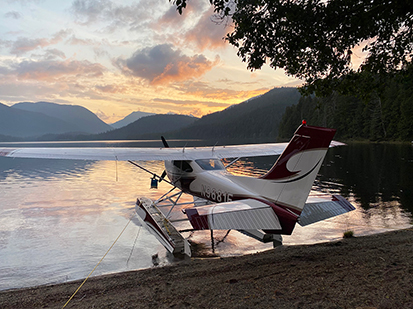
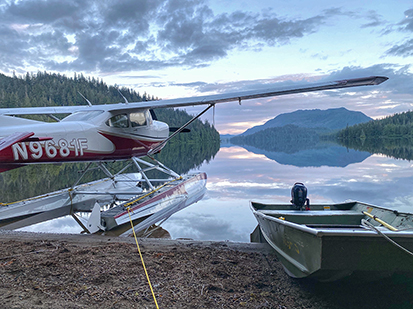
But it was now time to head south once again and return to normal life. I left Ketchikan on September 2nd after waiting three days for a “weather window.” After my arrival in Bellingham, Washington, and an overnight stay, it was on to California and then south through Arizona, New Mexico and into central Texas. The weather gods were not kind on the trip home either, with smoke from the wildfires, and their ensuing temporary flight restrictions (TFRs), followed by low ceilings, requiring instrument approaches to minimums. I finally landed at my home airport late in the day on September 9th, after flying for 85 hours.
After such an adventure, I think any pilot would reflect on the experience to consider what he or she learned. I also asked some of my partners to provide their perspectives as well.
All of us felt the trip was absolutely magical! Being able to access and enjoy the public-use cabins of the Tongass National Forest is an opportunity not to be missed if you have the chance. I would also note, that if pilots don’t utilize these cabins more often, they will likely disappear. They are not getting a lot of use now, and the cost to maintain them has to be high. Some have already been removed.
Each of my guests treasured the opportunity to experience the Alaska wilderness in a completely authentic way. Everyone gained a renewed appreciation for the simple joys of being completely disconnected from modern life, while enjoying the peace and tranquility of simply sitting and watching the play of sunlight and mist on the steep ridges of the surrounding mountains.
Another key lesson involves being comfortable with uncertainty. Operating in the wilderness means things can quickly go seriously wrong and help will be slow in coming. Often the plan changes rapidly and pilots need to be ready with a viable alternative plan. For instance, we spent several extra days in Juneau and Ketchikan waiting for the weather to improve.
The trip planning is complex at times because the airplane is heavily loaded with all the necessary gear, so fuel loads are a big issue. We had to allow for contingencies where weather might require a diversion, but not carry any more than needed to improve airplane performance. Thankfully, the elevations and temperatures were favorable.
Much of the flying required operating close to the terrain, often in marginal weather. Mountain flying experience is essential, along with an accurate GPS. My airplane has a Garmin 796 GPS, which accepts a 100K topo map card for added detail.
Having the right equipment can reduce the risks, but not eliminate them. Communication devices, survival gear and a suitable airplane are all important, but having the relevant wilderness flight experience, and the patience to wait out the weather when necessary, are absolutely essential. But the rewards are also immense. Sharing the wilderness in a floatplane with others, who understand and embrace the challenges, creates memories that last a lifetime.
EDITOR’S NOTE: Ken Wittekiend is a 12,000-hour instrument-rated, single-engine land and sea pilot. He lives in Burnet, Texas, where he is a flight instructor and Designated Pilot Examiner.
